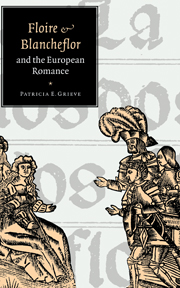Book contents
- Frontmatter
- Contents
- Preface
- Introduction
- Part One Floire and Blancheflor as Peregrinus
- Part Two The road to conversion
- 2 Cunning and ingenuity or Divine Intervention?
- 3 Signs, wonders and the telling of the tale
- 4 Routes of conversion: time and space
- 5 Generic crossroads
- Epilogue: Poetics of continuation
- Appendices
- Bibliography
- Index
- CAMBRIDGE STUDIES IN MEDIEVAL LITERATURE
3 - Signs, wonders and the telling of the tale
Published online by Cambridge University Press: 15 December 2009
- Frontmatter
- Contents
- Preface
- Introduction
- Part One Floire and Blancheflor as Peregrinus
- Part Two The road to conversion
- 2 Cunning and ingenuity or Divine Intervention?
- 3 Signs, wonders and the telling of the tale
- 4 Routes of conversion: time and space
- 5 Generic crossroads
- Epilogue: Poetics of continuation
- Appendices
- Bibliography
- Index
- CAMBRIDGE STUDIES IN MEDIEVAL LITERATURE
Summary
Throughout the various versions of Floire and Blancheflor, the reader or listener encounters a variety of inscribed texts from specific references to authors and ancient narratives to iconographic representations. The extent to which each version employs an inscribed text and the intended function of that text vary greatly. As an audience within a given work, characters and narrators engage in the activities of reading, writing and storytelling which encourage interpretation of the tales by the audience beyond the work and by the characters themselves. Within the stories, the programmatic images – literary and iconographic – enhance the narrative, propel the story forward, and in at least one case, that of the Spanish Chronicle, help to establish a national identity. The inscribed texts focus the attention of the audience on something outside the story itself, either as part of the structure of meaning within the tale or as a means of creating links between this text and others. The most complex examples of the intricacy of inscribed textual patterns occur in the aristocratic French version, Boccaccio's Il Filocolo, the Spanish Chronicle and the Spanish prose romance.
Roberta Krueger first mentioned the distinctive literariness of the aristocratic French version as opposed to the popular version, which exchanges idyllic scenes for those of armed combat.
- Type
- Chapter
- Information
- 'Floire and Blancheflor' and the European Romance , pp. 86 - 133Publisher: Cambridge University PressPrint publication year: 1997

